How does a Passive Solar Water Heater work?

Passive Solar Water Heaters in the world:
- In 2007, solar hot water systems global capacity, reached 154 GW, 70 GW of which were installed in China.
- 90% of homes in Israel and Cyprus use them to heat water.
- 18 GW of solar thermal energy were produced in the USA, Canada and Australia in 2005 to heat swimming pools.
What is a Passive Solar Water Heater?It is a system that takes solar thermal energy and transforms it to hot water without using any other form of energy. The big advantage here is that not only solar is
green energy but it is free too. Thus, these systems are really profitable.
Why Passive?
Because no other forms of energy need to be used. We just expose the absorber to the sun.
A second category called active solar water heater, uses a pump to circulate water. These systems can be run using electricity from a PV panel (zero carbon systems), or main electricity which reduces the carbon offsets by 20% (low carbon systems).
Although zero carbon systems are economic enough, passive systems tend to be more efficient. They use the natural ability of the hot water to go above the cold, and thus they create circulation. For more information have a look at Thermosiphon passive solar water heater.
How does a Passive Solar Water Heater work?
These systems use the basic principles of the greenhouse effect to produce heat. The hole idea is to trap some fluid (air, water, etc) in a place, and leave sunlight through the "walls" in order to heat the inside. This technology might seem too simple, but it is productive enough.
In fact, some systems provide efficiency up to 70%. That means that they harvest the 70% of the solar energy radiated at an area and transform it to hot water.
The 5 basic types of passive solar water heater systems available in the global market:
- Glazed Flat plate collectors
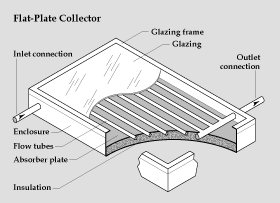 These consist of an insulated metal box with a glass or plastic cover and a black absorber plate. The box is filled with air or water.
These consist of an insulated metal box with a glass or plastic cover and a black absorber plate. The box is filled with air or water.
When sun hits the absorber plate, heat is transfered to the fluid in the box. Tubes filled with circulating water pass through the liquid and absorb the heat.
Temperatures reach up to 30-70°C (86-158°F). Thus, flat-plate collectors are ideal for water heating for homes and solar space heating.
- Unglazed Flat plate collectors
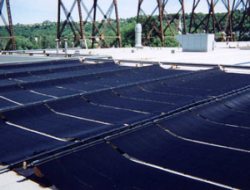 These systems work just like glazed collectors. The only difference is that there is no insulation.As a result, they provide lower temperatures (by 30°C) and they are mostly used for swimming pool heating, and pre-heating of water for car washes.
These systems work just like glazed collectors. The only difference is that there is no insulation.As a result, they provide lower temperatures (by 30°C) and they are mostly used for swimming pool heating, and pre-heating of water for car washes.
- Liquid-based solar collectors
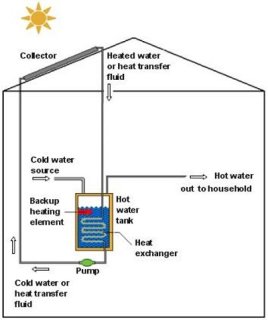 Work in the same way as the two systems above, with the only difference that the fluid heated is not the actual fluid to be used. Instead, it is driven through pipes which are connected in a circle and pass through a water tank. Heat is transfered from the pipes to the water in the tank and the water is used wherever needed.
Work in the same way as the two systems above, with the only difference that the fluid heated is not the actual fluid to be used. Instead, it is driven through pipes which are connected in a circle and pass through a water tank. Heat is transfered from the pipes to the water in the tank and the water is used wherever needed.
Note: The picture shows a pump which circulates the water. However, the system described above is a passive one and it does NOT use a pump.
- Evacuated Tube Collectors
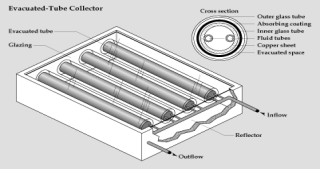 They consist of tubes insulated using two homo-centric glass tubes. These glass tubes form a vacuum space to prevent heat loss from the central, water containing tube - absorber. Sun hits the central tube and provides thermal power.
They consist of tubes insulated using two homo-centric glass tubes. These glass tubes form a vacuum space to prevent heat loss from the central, water containing tube - absorber. Sun hits the central tube and provides thermal power.
Evacuated tube collectors are divided in two categories: Direct-flow evacuated-tube collectors and Heat pipe evacuated-tube collectors.
The system achieves high temperatures, raging from 77°C (170°F) to 177°C (350°F). Parallel rows of glass tubes connected together, form an evacuated tube collectors panel.
Unfortunately, this system is quite expensive, while it reaches about twice the price of flat-plate collectors.
- Batch solar heaters
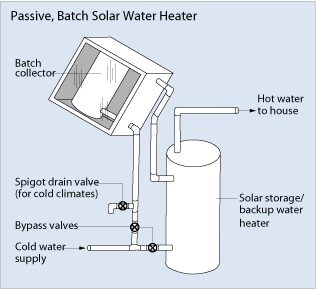 You maybe also know it as bread box system or integral collector storage system. It consists of one or more water tanks inside a box which allows sunlight pass through. The water tank is actually the absorber which attracts the sunlight to warm the water. It is the cheapest method of the three mentioned here but also the least effective.
You maybe also know it as bread box system or integral collector storage system. It consists of one or more water tanks inside a box which allows sunlight pass through. The water tank is actually the absorber which attracts the sunlight to warm the water. It is the cheapest method of the three mentioned here but also the least effective.
P.S. Passive Solar Water Heaters are the most efficient and environment friendly systems to heat water for residential and commercial use. They are such effective because they use the solar thermal energy without transforming it to a different form.
Remember: Sun is so powerful that can even cool and ventilate your house's air. If you are still using electricity to heat water and air at your house, please reconsider your decision!...





 These consist of an insulated metal box with a glass or plastic cover and a black absorber plate. The box is filled with air or water.
These consist of an insulated metal box with a glass or plastic cover and a black absorber plate. The box is filled with air or water.  These systems work just like glazed collectors. The only difference is that there is no insulation.As a result, they provide lower temperatures (by 30°C) and they are mostly used for swimming pool heating, and pre-heating of water for car washes.
These systems work just like glazed collectors. The only difference is that there is no insulation.As a result, they provide lower temperatures (by 30°C) and they are mostly used for swimming pool heating, and pre-heating of water for car washes. Work in the same way as the two systems above, with the only difference that the fluid heated is not the actual fluid to be used. Instead, it is driven through pipes which are connected in a circle and pass through a water tank. Heat is transfered from the pipes to the water in the tank and the water is used wherever needed.
Work in the same way as the two systems above, with the only difference that the fluid heated is not the actual fluid to be used. Instead, it is driven through pipes which are connected in a circle and pass through a water tank. Heat is transfered from the pipes to the water in the tank and the water is used wherever needed. They consist of tubes insulated using two homo-centric glass tubes. These glass tubes form a vacuum space to prevent heat loss from the central, water containing tube - absorber. Sun hits the central tube and provides thermal power.
They consist of tubes insulated using two homo-centric glass tubes. These glass tubes form a vacuum space to prevent heat loss from the central, water containing tube - absorber. Sun hits the central tube and provides thermal power.  You maybe also know it as bread box system or integral collector storage system. It consists of one or more water tanks inside a box which allows sunlight pass through. The water tank is actually the absorber which attracts the sunlight to warm the water. It is the cheapest method of the three mentioned here but also the least effective.
You maybe also know it as bread box system or integral collector storage system. It consists of one or more water tanks inside a box which allows sunlight pass through. The water tank is actually the absorber which attracts the sunlight to warm the water. It is the cheapest method of the three mentioned here but also the least effective.